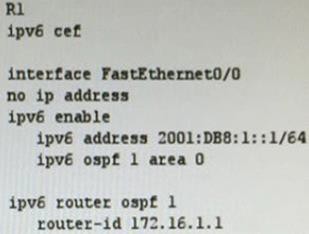Refer to the exhibit.
After you apply the given configuration to R1, you Notice that it failed to enable OSPF Which action can you take to correct the problem?

A. Configure a loopback interface on R1
B. nable IPv6 unicast Routing on R1
C. Configure an IPv4 address on interface FO/0
D. Configure an autonomous system number on OSPF
Pass Cisco CCNA 200-301 Exam in First AttemptFULL Printable PDF and Software. VALID exam to help you pass. |
 |


The TFTP server must have a network connection to the router and must be able to ping the IP address of the router targeted for a TFTP software upgrade. In order to achieve this connection, the router interface and the TFTP server must have an IP address in the same range or a default gateway configured.
Check the IP address of the TFTP server in order to verify this configuration.
Answer is B
R1(config)#ipv6 cef
%Must enable IPv6 routing first
R1(config)#
TestR1#conf t
Enter configuration commands, one per line. End with CNTL/Z.
TestR1(config)#ipv6 cef
%Must enable IPv6 routing first
TestR1(config-if)#ipv6 address 2001:db8:1::1/64
TestR1(config-if)#ipv6 ospf 1 area 0
% OSPFv3: IPv6 routing not enabled
You cant enbale ipv6 cef or ospf on the interface without enabling unicast routing –
The Answer is B – Another misleading answer
From what is shown you can see that router ID is already stated as 172.16.1.1 which is IPv4 address. Router1 will try to present itself with this ID to other OSPF potential neighbors. This IP address is not configured and it should be. Correct answer is C.
Answer is S
The answer should be B because i do not see ipv6 unicast routing enabled globally.
I thought you could not type ospfv3 commands without enabling ipv6 unicast-routing.
ikr. so i dont understand why B is the correct answer
The correct answer is B.
Only ospfv3 deals with IPv6. For IPv4 must be ospf (which is v2).
B